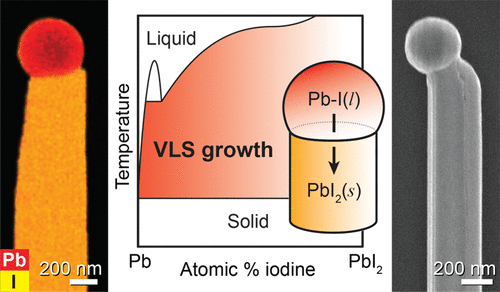当前位置:
X-MOL 学术
›
Nano Lett.
›
论文详情
Our official English website, www.x-mol.net, welcomes your feedback! (Note: you will need to create a separate account there.)
Self-Catalyzed Vapor–Liquid–Solid Growth of Lead Halide Nanowires and Conversion to Hybrid Perovskites
Nano Letters ( IF 10.8 ) Pub Date : 2017-11-13 00:00:00 , DOI: 10.1021/acs.nanolett.7b03514 Jonathan K. Meyers , Seokhyoung Kim , David J. Hill , Emma E. M. Cating , Lenzi J. Williams , Amar S. Kumbhar , James R. McBride 1 , John M. Papanikolas , James F. Cahoon
Nano Letters ( IF 10.8 ) Pub Date : 2017-11-13 00:00:00 , DOI: 10.1021/acs.nanolett.7b03514 Jonathan K. Meyers , Seokhyoung Kim , David J. Hill , Emma E. M. Cating , Lenzi J. Williams , Amar S. Kumbhar , James R. McBride 1 , John M. Papanikolas , James F. Cahoon
Affiliation

|
Lead halide perovskites (LHPs) have shown remarkable promise for use in photovoltaics, photodetectors, light-emitting diodes, and lasers. Although solution-processed polycrystalline films are the most widely studied morphology, LHP nanowires (NWs) grown by vapor-phase processes offer the potential for precise control over crystallinity, phase, composition, and morphology. Here, we report the first demonstration of self-catalyzed vapor–liquid–solid (VLS) growth of lead halide (PbX2; X = Cl, Br, or I) NWs and conversion to LHP. We present a kinetic model of the PbX2 NW growth process in which a liquid Pb catalyst is supersaturated with halogen X through vapor-phase incorporation of both Pb and X, inducing growth of a NW. For PbI2, we show that the NWs are single-crystalline, oriented in the ⟨1̅21̅0⟩ direction, and composed of a stoichiometric PbI2 shaft with a spherical Pb tip. Low-temperature vapor-phase intercalation of methylammonium iodide converts the NWs to methylammonium lead iodide (MAPbI3) perovskite while maintaining the NW morphology. Single-NW experiments comparing measured extinction spectra with optical simulations show that the NWs exhibit a strong optical antenna effect, leading to substantially enhanced scattering efficiencies and to absorption efficiencies that can be more than twice that of thin films of the same thickness. Further development of the self-catalyzed VLS mechanism for lead halide and perovskite NWs should enable the rational design of nanostructures for various optoelectronic technologies, including potentially unique applications such as hot-carrier solar cells.
中文翻译:

卤化铅纳米线的自催化汽-液-固生长并转化为杂化钙钛矿
卤化钙钛矿(LHPs)已显示出可用于光伏,光电探测器,发光二极管和激光器的巨大前景。尽管溶液处理的多晶膜是最广泛研究的形态,但是通过气相法生长的LHP纳米线(NW)提供了精确控制结晶度,相,组成和形态的潜力。在这里,我们报道了卤化铅(PbX 2; X = Cl,Br或I)NWs的自催化气液固(VLS)增长和向LHP转化的首次证明。我们提出了一种PbX 2 NW生长过程的动力学模型,其中液态Pb催化剂通过Pb和X的气相掺入与卤素X过饱和,从而诱导NW的生长。对于PbI 2,我们显示NW是单晶的,朝向⟨1̅21̅0⟩方向,并且由化学计量的PbI 2轴和球形Pb尖端组成。甲基碘化铵的低温气相插入将NW转化为甲基铵碘化铅(MAPbI 3)钙钛矿,同时保持NW形态。单次NW实验将测得的消光光谱与光学模拟进行了比较,结果表明NW表现出很强的光学天线效应,从而导致散射效率大大提高,吸收效率可能是相同厚度薄膜的两倍以上。卤化铅和钙钛矿型纳米线的自催化VLS机理的进一步发展,应能够合理设计各种光电技术的纳米结构,包括潜在的独特应用,例如热载流子太阳能电池。
更新日期:2017-11-14
中文翻译:

卤化铅纳米线的自催化汽-液-固生长并转化为杂化钙钛矿
卤化钙钛矿(LHPs)已显示出可用于光伏,光电探测器,发光二极管和激光器的巨大前景。尽管溶液处理的多晶膜是最广泛研究的形态,但是通过气相法生长的LHP纳米线(NW)提供了精确控制结晶度,相,组成和形态的潜力。在这里,我们报道了卤化铅(PbX 2; X = Cl,Br或I)NWs的自催化气液固(VLS)增长和向LHP转化的首次证明。我们提出了一种PbX 2 NW生长过程的动力学模型,其中液态Pb催化剂通过Pb和X的气相掺入与卤素X过饱和,从而诱导NW的生长。对于PbI 2,我们显示NW是单晶的,朝向⟨1̅21̅0⟩方向,并且由化学计量的PbI 2轴和球形Pb尖端组成。甲基碘化铵的低温气相插入将NW转化为甲基铵碘化铅(MAPbI 3)钙钛矿,同时保持NW形态。单次NW实验将测得的消光光谱与光学模拟进行了比较,结果表明NW表现出很强的光学天线效应,从而导致散射效率大大提高,吸收效率可能是相同厚度薄膜的两倍以上。卤化铅和钙钛矿型纳米线的自催化VLS机理的进一步发展,应能够合理设计各种光电技术的纳米结构,包括潜在的独特应用,例如热载流子太阳能电池。

























 京公网安备 11010802027423号
京公网安备 11010802027423号